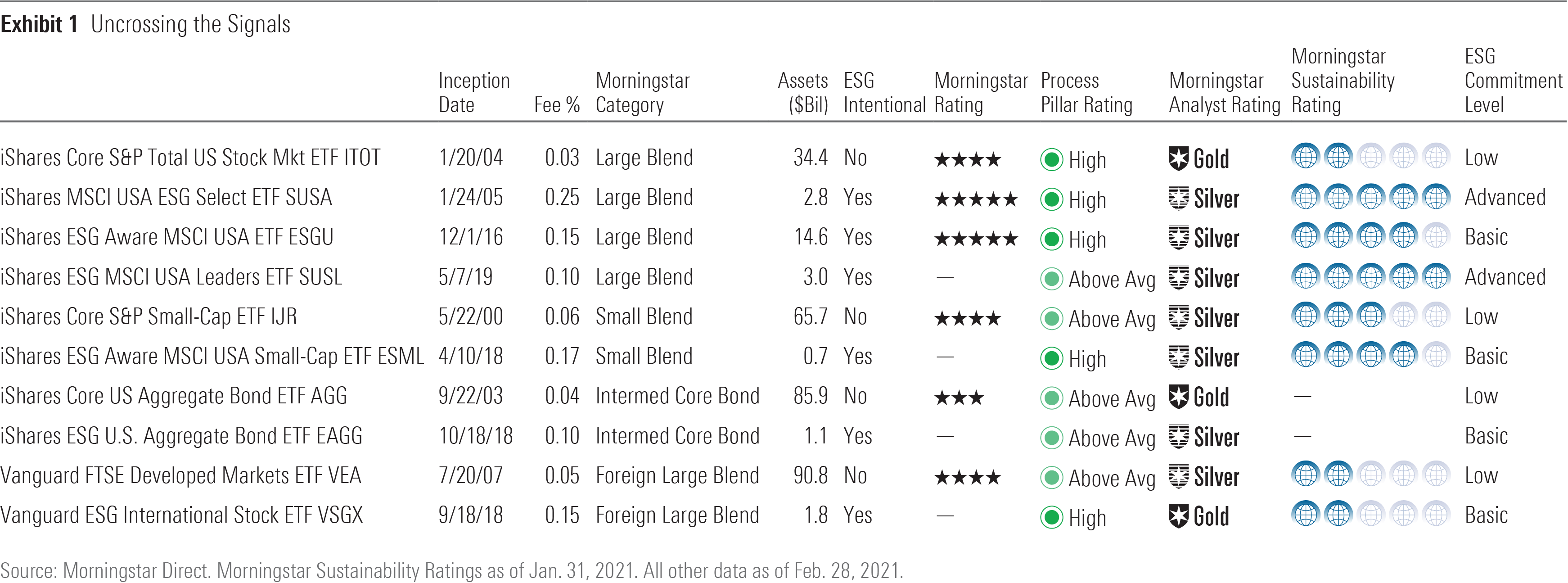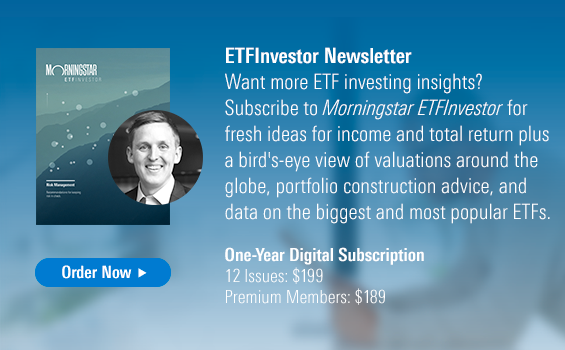What Morningstar Indicators Do and Don't Say About ESG
How to use our metrics to gauge how sustainable a fund is.
A version of this article previously appeared in the March 2021 issue of Morningstar ETFInvestor. Click here to download a complimentary copy.
Environmental, social, and governance investing has made it into the mainstream in recent years. Shifting investor preferences, new regulation, and mounting climate, social, and governance crises have supported this trend. The asset-management industry has responded. Fund company CEOs are putting ESG at the top of their agendas, new funds are being minted every day, and many old funds are finding new life as ESG-intentional versions of their former selves. As of the end of February, the number of ESG exchange-traded funds listed in the United States had jumped to 123 from 24 at the end of February 2016. Assets invested in these ETFs grew faster yet, climbing to $80.8 billion from $3.7 billion over that same span.
Investors mulling ESG-intentional strategies are faced with a massive menu and a dizzying array of definitions, data, and research.
Four of Morningstar’s signature signals can help cut through this noise. But it is important to understand the questions each of them answers. Some are relevant to funds’ performance and investment merit and ignore ESG risk. Others measure the ESG risks funds face or how they incorporate ESG into their investment process. Here, I’ll address each of these indicators in turn.
How Has This Fund Performed?
The Morningstar Rating for funds, aka the star rating, provides a succinct answer to this question. The original Morningstar Rating was introduced in 1985. The inputs to this rating are strictly backward-looking and quantitative. The star rating compares funds’ risk-adjusted historical returns against their Morningstar Category peers. The risk adjustment disproportionately penalizes downside risk. This is because investors dislike downside risk far more than they enjoy upside risk.
Funds first receive a star rating shortly after their three-year anniversaries. The rating is calculated over a three-, five-, and 10-year lookback. For the period in question, funds with a Morningstar Risk-Adjusted Return ranking in the top 10% of their category receive a 5-star rating, the next 22.5% a 4-star rating, the next 35% a 3-star rating, the next 22.5% a 2-star rating, and the bottom 10% a 1-star rating. The overall star rating is a weighted average of funds’ three-, five-, and 10-year ratings. Funds with just three to five years of history receive a 100% weighting on their three-year rating. Funds with five to 10 years of history have an overall rating that assigns a 60% weight to the five-year rating and a 40% weight to the three-year rating. The overall rating for funds with records of more than 10 years gives a 50% weight to the 10-year rating, a 30% weight to the five-year rating, and a 20% weight to the three-year rating.
The star rating is a useful starting point in fund selection. It tells investors how funds have fared versus their peers and accounts for risk. Its best use may be as a means of winnowing the field, as low-rated funds have historically been far more likely to be closed or merged into other funds than their higher-rated peers. [1]
How Might This Fund Perform in the Future?
While the Morningstar Rating looks back, the Morningstar Analyst Rating for funds looks ahead. The Analyst Rating was launched in November 2011. ETFs were first incorporated into the framework in November 2016. The Analyst Rating is a summary expression of our qualitative, forward-looking analysis of investment strategies. The Analyst Rating for funds is expressed on a five-tier scale running from Gold to Negative. For actively managed funds (we include strategic-beta index funds and ETFs in this cohort), the top three ratings of Gold, Silver, and Bronze all indicate that our analysts expect the rated investment vehicle to outperform its category index on a risk-adjusted basis over the long term, meaning a period of at least five years. For passive strategies, the same ratings indicate that we expect the fund to outperform its median category peer on a risk-adjusted basis over the long term. The Analyst Rating does not express a view on a given asset class or peer group; rather, it seeks to evaluate each strategy and associated vehicle within the context of an appropriate benchmark and peer group. In other words, we’re not predicting the tide, but assessing the seaworthiness of the vessels in the harbor.
The Analyst Rating is a signal that is focused on investment merit. We scrutinize funds’ investment process, the people that manage them, and their parent firms. Our goal is to point investors toward best-of-breed strategies that are apt to perform well for a long time to come and to steer them away from those that will likely struggle.
How Much ESG Risk Does This Fund Face?
The Morningstar Sustainability Rating, which was launched in 2016, is a measure of the financially material ESG risks in a fund relative to its peer group. The rating is a historical holdings-based calculation that uses the company-level ESG Risk Rating from Sustainalytics, a Morningstar subsidiary that is a leading provider of ESG research. It is calculated for managed products and indexes globally using Morningstar’s portfolio holdings database.
The Sustainability Rating is the result of a three-step process. First, we calculate the Morningstar Portfolio Sustainability Score for every portfolio reported within the trailing 12 months. Second, we use these scores to calculate a fund’s Morningstar Historical Portfolio Sustainability Score. Third, we assign a Sustainability Rating to funds based on their Historical Portfolio Sustainability Score relative to their global category peers.
Based on their Historical Portfolio Sustainability Scores, funds are assigned absolute category ranks and percent ranks within their global categories, provided that a category has at least 30 portfolios with Historical Portfolio Sustainability Scores. The distribution of portfolios’ Sustainability Ratings follows the same pattern as the star rating, with the top 10% getting a High (5-globe) rating, and so on.
The Sustainability Rating provides a useful snapshot of how much ESG risk might be present in a particular fund, but it doesn’t differentiate between strategies that set out to manage ESG risks and those that set ESG considerations aside.
To What Extent Does This Fund Aim to Incorporate ESG Criteria Into Its Process?
The Morningstar ESG Commitment Level made its debut in 2020. It expresses our analysts’ assessment of individual strategies’ and asset managers’ determination to incorporate ESG factors into their investment processes and organizations. It is assigned to both strategies and asset managers following a four-tier scale: Leader, Advanced, Basic, and Low.
For actively managed funds, we review three key pillars: Process, Resources, and Asset Manager. Process includes an assessment of the manner and extent to which ESG factors are incorporated into a fund’s investment process, from the definition of the investable universe (screening) to research, security selection, portfolio construction, risk management, active ownership efforts (proxy voting and engagement with respect to ESG issues), and transparency of reporting. Resources assesses the amount of data sources used by the fund’s investment team as well as the ESG expertise both on the team and otherwise accessible to the team. Asset Manager reflects the ESG Commitment Level of the parent firm behind the strategy. Each pillar is scored and then rolled into the overall ESG Commitment Level by weighting them as follows: Process (45%), Resources (35%), and Asset Manager (20%).
For passively managed funds, we review two key pillars: Process and Asset Manager. This approach reflects the fact that nearly all passive ESG offerings are based on indexes licensed from third-party providers, with the index methodology itself shaping the ESG profile of the fund. Given this, data and ESG specialist personnel at the fund level aren’t material to our assessment. We therefore exclude the Resources Pillar from our assessment of passively managed funds and focus primarily on Process, with the resulting weights as follows: Process (80%) and Asset Manager (20%).
The ESG Commitment Level gives investors a read on the degree to which ESG considerations shape funds’ investment processes. Some funds and asset managers have legitimate ESG bona fides, others leave ESG considerations out of their investment processes altogether.
Uncrossing the Signals
These four signals answer four different questions for investors. The star rating and Analyst Rating focus on performance: past and prospective. Neither of these ratings focuses on ESG risk or ESG integration, although the star rating includes ESG risk to the extent that ESG risk influences past performance. The Sustainability Rating and ESG Commitment Level assess ESG risk and funds’ efforts to incorporate the analysis and mitigation of ESG risks into their investment processes. As it pertains to performance, the pair of ESG signals is agnostic. These four signals are intended to complement one another. They provide concise, useful answers to four distinct questions. These answers cut through the noise and can help inform investors’ choices.

[1] Setting the Record Straight on Our Fund Ratings
Disclosure: Morningstar, Inc. licenses indexes to financial institutions as the tracking indexes for investable products, such as exchange-traded funds, sponsored by the financial institution. The license fee for such use is paid by the sponsoring financial institution based mainly on the total assets of the investable product. Neither Morningstar, Inc. nor its investment management division markets, sells, or makes any representations regarding the advisability of investing in any investable product that tracks a Morningstar index.


/s3.amazonaws.com/arc-authors/morningstar/a90ba90e-1da2-48a4-98bf-a476620dbff0.jpg)
/d10o6nnig0wrdw.cloudfront.net/09-25-2023/t_f3a19a3382db4855b642d8e3207aba10_name_file_960x540_1600_v4_.jpg)
/d10o6nnig0wrdw.cloudfront.net/04-09-2024/t_e87d9a06e6904d6f97765a0784117913_name_file_960x540_1600_v4_.jpg)
/cloudfront-us-east-1.images.arcpublishing.com/morningstar/T2LGZCEHBZBJJPPKHO7Y4EEKSM.png)
:quality(80)/s3.amazonaws.com/arc-authors/morningstar/a90ba90e-1da2-48a4-98bf-a476620dbff0.jpg)